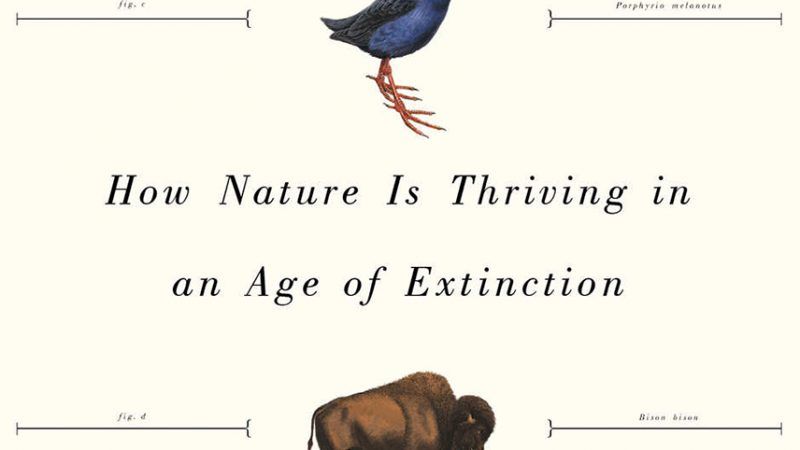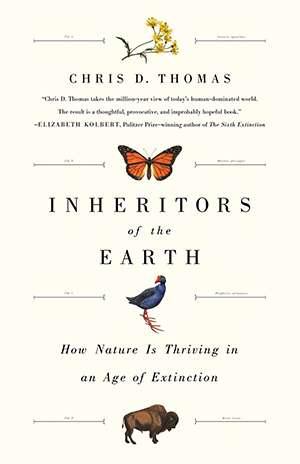Humanity Isn't Destroying the Natural World. We're Changing It.
Welcome to Anthropocene Park.

Inheritors of the Earth: How Nature Is Thriving in an Age of Extinction, by Chris D. Thomas, PublicAffairs, 320 pages, $28

Humanity isn't destroying the natural world. We're changing it. And in many ways, our changes are creating richer and more vibrant ecosystems.
That's the persuasive and liberating argument advanced by the York University conservation biologist Chris D. Thomas in his riveting new book, Inheritors of the Earth: How Nature Is Thriving in an Age of Extinction. "It is time for the ecological, conservation and environmental movement—of which I am a life-long member—to throw off the shackles of a pessimism-laden, loss-only view of the world," he writes. Instead, he thinks a thriving world of exotic ecosystems and biological renewal is at hand. By the time readers have finished this carefully researched treatise, they should agree.
Thomas' thesis isn't exactly the conventional wisdom. In her Pulitzer-winning 2015 book The Sixth Extinction (Henry Holt and Co.), journalist Elizabeth Kolbert argues that current species losses are comparable to the five prior mass extinctions that have occurred in the past 540 million years. In each case, around 75 percent of then-living species were killed off. Kolbert and the biologists she cites suggest not just that a sixth such event is underway but that human activities are the chief cause of the disaster.
Last year, the Stanford biologist Paul Ehrlich made a similar argument in the Proceedings of the National Academy of Sciences, concluding that all trends are "painting a dismal picture of the future of life, including human life." Inheritors of the Earth brilliantly demonstrates that there are good scientific reasons to doubt these dire prophecies.
Thomas forthrightly acknowledges that the "'extinction crisis' is real" and "we are in the process of losing many species that existed before humans arrived on the scene." Researchers estimate that 178 of the world's largest mammal species disappeared before 1500. Since then, the International Union for the Conservation of Nature reports that 2 percent of mammals, 1.6 percent of birds, and 2 percent of amphibians have gone extinct. "This loss is devastating," Thomas writes, "but, luckily, it isn't the whole story."
He observes that by 2000, human beings accounted for about 30 percent of the biomass of all land mammals, with our domestic livestock making up 67 percent of the rest. Due to human activities, the total amount of mammal flesh is "over seven times greater than it was before humans came along." And this does not take into account the billions of domestic poultry we raise. The upshot is that "the natural state of the world—to be full of large herbivorous animals and carnivores that eat them—continues to the present day."
Meanwhile, as people grow wealthier and agriculture more productive, fewer folks have to hunt for food or cut down forests for farms, so more space opens up for the return of wild nature. As a result, European bison have grown from a single wild population to 33; beaver populations have increased by 14,000 percent since mid-century; deer and wild boar in Europe have quadrupled since 1960.
Predators are increasing, too. For example, European gray wolf and lynx populations have risen by more than 300 percent since the '60s.
Similarly, the white-tailed deer population in the United States went from 300,000 in the 1930s to over 30 million today; bison have gone from just over 1,000 in 1890 to more than half a million today. Black bears were locally extinct in many parts of the contiguous United States in 1900; more than 300,000 are now estimated to roam the lower 48 states. Killed off in the eastern U.S. by the 1930s, mountain lions now number more than 30,000 and are spreading eastward. "Once we stop killing them, large animals come back, rejoining the 90-plus percent of smaller ones that never disappeared in the first place," observes Thomas.
Humanity is also creating a new Pangaea by moving thousands of species around the globe and thereby increasing local biodiversity almost everywhere. We are, in Thomas' words, "acting as dispersal agents for other plants and animals."
New Zealand's 2,000 native plant species have been joined by 2,000 from elsewhere, doubling the plant biodiversity of its islands. Meanwhile, only three of New Zealand's native plants have gone extinct. In California, 1,000 new species of vascular plants have joined the state's 6,000 native species, while fewer than 30 species have gone extinct. Overall, Thomas estimates that "roughly one in a thousand species that arrives [at a new location] causes a real issue for the native animals and plants."
Indeed, moving species around has turned some that were on the brink of extinction into ecological winners. Take the Monterey Pine: Endangered in its California coastal homeland, it is now thriving in New Zealand, Chile, Australia, Argentina, Kenya, and South Africa. Accumulating evidence shows that many introduced species of plants and animals are improving ecosystems by increasing local biomass and speeding up the recycling of nutrients and energy.
As plants and animals populate new regions, they start down different evolutionary paths that are already transforming some of them into new species. Spanish star thistles transplanted to California and allowed time to evolve are much less fertile when crossbred with their European ancestors—a sign that the two sets of thistles have significantly diverged. Australian crickets in Hawaii have evolved so that they no longer chirp and thus have a greater chance of staying hidden from the flies that want to lay their eggs on them. European hawthorn flies have adapted to lay their eggs on apples in North America. "We are living through a period of rapid formation of new populations, races, and species," Thomas writes.
Many ecologists view this worldwide mixing and matching with revulsion. Neophobe biologists James Russell and Tim Blackburn, for instance, recently denounced researchers who do not automatically condemn introduced biota as "invasive species denialists," likening them to people who challenge the scientific consensus on "the risks of tobacco smoking or immunisation, the causes of AIDS or climate change, [and] evidence for evolution."
Such researchers behave, Thomas writes, "as if there is an 'ought to be' state of the world, with each species having its own 'correct' location." But species and ecosystems have been evolving for eons. "Nature just happens, and the distributions of species change—no slice of time has any more or less merit than any other."
At the end of the last ice age, continental glaciers reached 300 to 400 miles north of where my house now stands in central Virginia. The countryside then consisted of forests of spruce, fir, jack pine, alder, and birch; mammoths and musk oxen roamed within them.
As the climate warmed, these trees and oxen moved north to Canada and the mammoths went extinct. While the glaciers melted, deciduous trees like poplar, oak, hickory, and chestnut began their march out of various southern refugia and became preponderant in the local forests.
Even then human beings were reshaping the landscape. Native Americans used fire to create extensive grass and shrub lands that were more suitable for game animals like deer and elk.
Since ecological change is inevitable, Thomas urges us to throw aside static notions of restoring local ecosystems to some imagined prehuman Edenic state. Instead, we should embrace our central role in molding the natural world and become more proactive in managing species and landscapes. "Our aim should be to maintain robust ecosystems (however different from those that exist now or existed in the past) and species, rather than defend an unstable equilibrium," argues Thomas. "We can let change happen."
Why not "rewild" parts of North America that once contained mammoths, camels, and saber-tooth tigers with ecologically similar species from other parts of the world? Let's loose elephants, lions, cheetahs, camels, and llamas to roam unpopulated regions of the West. In place of the now-extinct woolly rhinoceros and European hippopotamus, why not settle the Sumatran hairy rhinoceros and African hippopotamus in the Camargue wetlands of southern France? Or transplant giant flightless birds—ostriches, rheas, cassowaries—to New Zealand, where they can fill the ecological niches of the giant moas eaten to extinction by the Maoris' Polynesian ancestors?
"We can think about engineering new ecosystems and biological communities into existence, inspired but not constrained by the past," argues Thomas. Employing such strategies also means that "we can protect plants and animals in places where it is feasible to do so, rather than where they came from."
Thomas accepts that we are now living in the Anthropocene, a new geological age in which human activity has become the dominant influence on the earth's environment. While our impacts on nature are sometimes regrettable, the trajectory of this exciting era may well bring many more gains than losses for both humanity and the resilient natural world around us.
This article originally appeared in print under the headline "Life Finds a Way."


Show Comments (212)